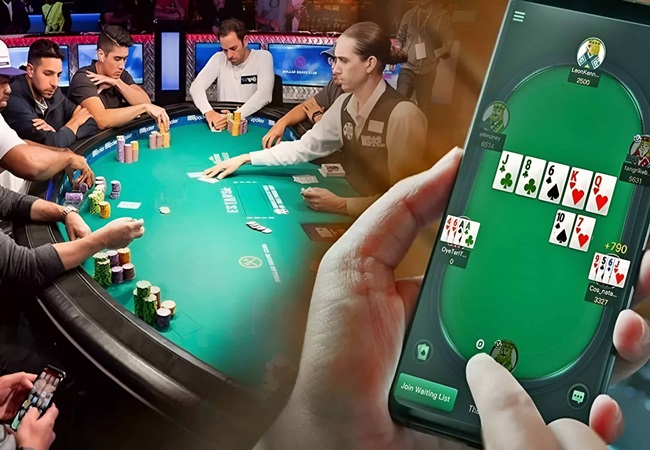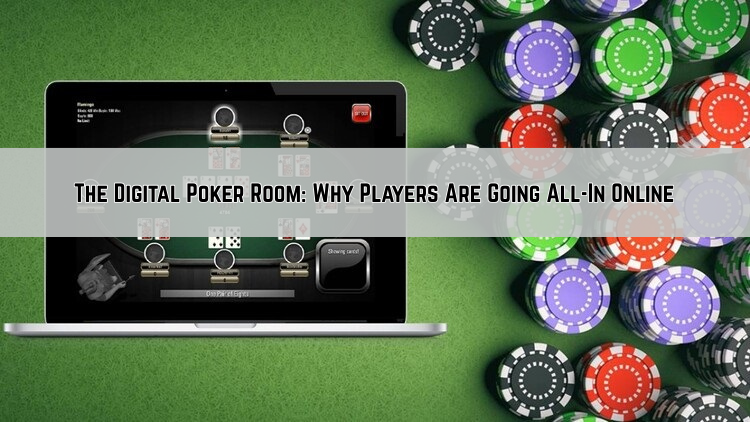The Digital Poker Room: Why Players Are Going All-In Online
Poker has long been one of the most popular card games in the world, blending luck, strategy, and psychology into an experience that has fascinated players for generations. Traditionally, poker meant smoky casinos, private tables among friends, or glamorous tournaments in Las Vegas. But over the past two decades—and especially in recent years—poker and Rummy games have undergone a dramatic transformation. The digital age has brought poker into the pockets of millions, creating a thriving online ecosystem where players from every corner of the globe meet to test their skills.
This evolution has given rise to what many now call the digital poker room, a space where technology, community, and competition converge. So why are so many players going “all-in” online? Let’s explore the driving forces behind this massive shift.

1. Accessibility: Poker Without Borders
Perhaps the most obvious advantage of digital poker rooms is accessibility. No longer do players need to live near a casino or organize a weekly home game to enjoy poker. With just a smartphone, tablet, or laptop, anyone can log in and play.
Online poker platforms and Teen Patti Stars have broken geographical barriers. Players from Asia can square off against opponents in Europe, while Americans test their skills against players in South America. This interconnectedness has turned poker into a truly global game, where cultural and geographical divides dissolve at the table.
Additionally, online poker never closes. Traditional casinos operate on fixed schedules, but digital poker rooms are open 24/7, allowing players to play a quick hand during a lunch break or grind through tournaments deep into the night. For many, this flexibility is a game-changer.
2. Variety of Games and Stakes
In physical poker rooms, options can be limited by space and demand. Maybe only a few tables are open, or only certain variants like Texas Hold’em are offered. Online poker rooms eliminate those constraints.
Today’s platforms provide an almost endless menu of formats:
- Texas Hold’em (No Limit, Pot Limit, Fixed Limit)
- Omaha and Omaha Hi-Lo
- Seven-Card Stud
- Razz and Mixed Games like HORSE
- Fast-Fold Poker (where players instantly move to a new hand after folding)
- Spin-and-Go Tournaments with randomized prize pools
Equally important, players can find stakes to suit every bankroll. From micro-stakes where beginners risk just a few cents, to nosebleed cash games with blinds in the thousands, there’s a seat for everyone. This inclusivity attracts casual hobbyists, grinders looking to earn steady income, and high rollers chasing huge pots.
3. The Digital Poker Room: Technology and User Experience
Modern digital poker rooms have become highly sophisticated. Early platforms were clunky and slow, but today’s apps and websites deliver sleek, intuitive interfaces with features that enhance gameplay.
Key innovations include:
- Multi-tabling: Players can sit at several tables simultaneously, something impossible in live poker or at live tables.
- Hand histories and tracking tools: Serious players can review past games to analyze mistakes and improve strategy.
- HUDs (Heads-Up Displays): Many platforms integrate or support third-party tools that provide real-time statistics on opponents.
- Mobile optimization: Poker apps now run smoothly on smartphones, allowing gaming on the go.
Technology has also improved fairness. Random Number Generators (RNGs) ensure shuffles are unbiased, while advanced security protocols protect players’ funds and data. These safeguards help establish trust in the digital environment.
4. Bonuses, Rewards, and Promotions
Unlike brick-and-mortar casinos, which rarely offer poker-specific incentives, online platforms aggressively compete for players with bonuses and loyalty rewards.
These can include:
- Welcome bonuses that match a player’s first deposit.
- Freeroll tournaments where players can enter without risk and still win real prizes.
- Rakeback programs return a percentage of the house fee to players.
- Leaderboards and missions that add a gamified layer to the experience.
For many, these incentives provide added value that makes online play more attractive than live poker room. Beginners can stretch their bankrolls further, while experienced grinders maximize profits through volume.

5. The Global Competitive Scene
Online poker has not just expanded the player base—it has reshaped the competitive landscape. Platforms host daily, weekly, and seasonal poker tournaments with massive prize pools. Some of the world’s most famous events, such as the World Series of Poker (WSOP), now have online editions, allowing players to compete for coveted bracelets without ever setting foot in Las Vegas.
These online competitions have created opportunities for players who might never have had access to live events due to travel costs or visa restrictions. Stories abound of amateurs who won life-changing sums from the comfort of their homes, cementing online poker as a legitimate pathway to success.
6. Community and Social Features
Contrary to the belief that online play is isolating, digital poker rooms often foster strong communities. Many platforms include chat functions, friend lists, and clubs where like-minded players can gather.
In recent years, streaming platforms like Twitch and YouTube have further enhanced the social side of online poker. Professional players stream their sessions, offering insights, strategies, and entertainment to thousands of viewers. This has created a new kind of engagement where fans can learn from and interact with their poker heroes in real time.
Some of the best apps even experiment with VR (Virtual Reality) poker rooms, simulating the experience of sitting at a real table with avatars representing players. This blending of technology and social interaction continues to push boundaries.
7. The Appeal of Anonymity and Focus
For many, playing online offers an environment free from the distractions of live poker. There’s no need to maintain a poker face, read body language, or deal with table chatter. Players can focus solely on strategy and math.
At the same time, anonymity lowers barriers for beginners. New players often feel intimidated walking into a casino or home game where everyone seems more experienced. Online poker provides a low-pressure environment where mistakes are less embarrassing and learning can occur at one’s own pace.
8. Safer and More Regulated Environments
As online poker has grown, so has regulation. Many jurisdictions now license and oversee digital poker rooms, ensuring games are fair and secure. Player protections, responsible gaming tools, and anti-fraud measures are more robust than ever before.
For players, this means greater confidence in depositing money, withdrawing winnings, and knowing that the games they play are legitimate. While the industry has had its share of controversies in the past, today’s leading platforms operate with a high level of transparency.
9. A Training Ground for the Next Generation
Online poker has become the proving ground for many of the game’s top professionals. The sheer volume of hands one can play online dwarfs live play, allowing for faster learning and skill development. A player might see thousands of hands in a week online, compared to just a few hundred in live sessions.
This accelerated learning curve, combined with tracking software and educational resources, has produced a generation of highly analytical, mathematically skilled players. For aspiring pros, the digital poker room is often the first step toward greatness.
Conclusion: Why Players Are All-In
The shift to online poker isn’t simply a matter of convenience—it represents a broader evolution in how people play, connect, and compete. The digital poker room offers unparalleled accessibility, a wide range of options, enhanced security, and vibrant communities. It provides both a casual escape for recreational players and a serious platform for professionals chasing glory.
While live poker will always hold its charm—its tells, its atmosphere, its personal rivalries—the momentum is clearly digital. Players around the world are going all-in online not because they have to, but because online rummy and poker experiences have become richer, more rewarding, and more exciting than ever before.
The future of poker, it seems, will be played not just in the casinos of Las Vegas or Macau, but also on the screens we carry in our hands.

5 FAQ’s: Digital Poker Rooms: Going All-In Online
1. Why play poker online?
It’s fast, fun, and available anytime, anywhere.
2. What’s better about online vs. live?
More games, more players, more action.
3. Is it safe?
Yes—top apps use RNGs and security checks.
4. Can beginners join in?
Of course! Low stakes and freerolls make it easy.
5. What makes it exciting?
Cool features like multi-tabling, rewards, and even VR tables.







